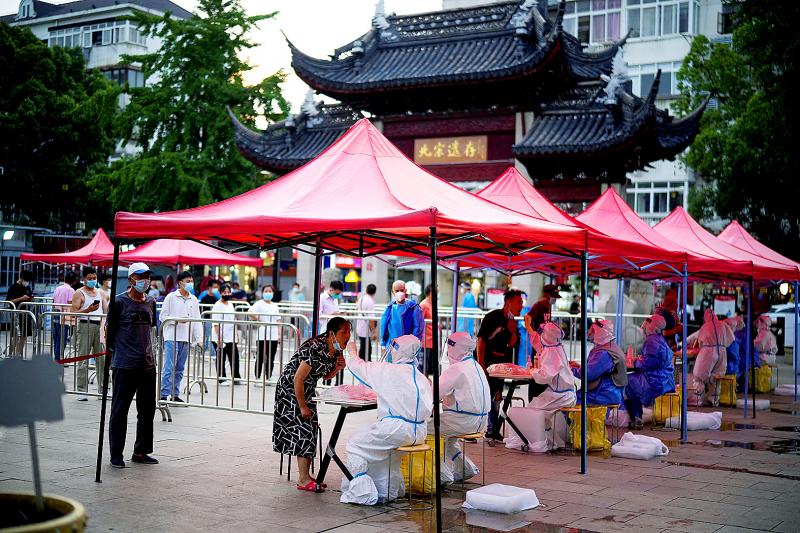Several large Chinese cities, including Shanghai, are on alert due to new clusters of COVID-19 infections, rolling out repeated mass testing or extending lockdowns on millions of residents, with some measures triggering a public outcry.
China has reported an average of about 390 local daily infections in the seven days ending on Sunday, higher than about 340 seven days earlier, according to Reuters calculations based on official data as of yesterday. That is tiny compared with a resurgence in other parts of Asia.
China is adamant about implementing its dynamic “zero COVID” policy of eliminating outbreaks as soon as they emerge. Previously, when a flare-up became a major outbreak, local officials had been compelled to take tougher measures such as month-long lockdowns, even at the cost of economic growth.

Photo: Reuters
Persistent outbreaks and more closures could add pressure on the world’s second-largest economy, which contracted sharply in the second quarter from the first after widespread COVID-19 lockdowns jolted industrial production and consumer spending.
Shanghai, yet to fully recover from the harsh two-month lockdown in spring and still reporting daily sporadic cases, plans to hold mass testing in many of its 16 districts and in some smaller areas where new infections had been reported recently, after similar testing last week.
“There is still an epidemic risk at the community level so far,” the city government said in a statement.
Shanghai reported more than a dozen new cases, but none was found outside quarantined areas, local government data showed.
“I’m speechless,” said a Shanghai resident surnamed Wang, already subject to testing every weekend at her residential compound. “It sounds like a waste of resources that doesn’t address the real problem.”
The northern city of Tianjin, which launched multiple rounds of mass testing in recent months to curb earlier outbreaks, yesterday said it was again testing its more than 12 million residents, after two local infections were found.
In the central Chinese city of Zhumadian, lockdowns for more than 1 million people in two towns under its jurisdiction are extended for a few days until today.
Temporary lockdowns for more than 3 million people in four other towns had been extended to yesterday. Zhumadian continues to report dozens of cases daily, despite curbs last week.
The southwestern city of Chengdu yesterday said it suspended various entertainment and cultural venues, widening such curbs over the weekend that had been limited to a few districts.
Beijing, after a week of zero local infections, yesterday found two local cases — one international flight crew member and the person’s roommate. Authorities have sealed up affected buildings.
In the southern city of Guangzhou, COVID-19 control staffers broke down the locks of apartment doors without residents’ consent, stirring an outcry on social media over the weekend.
Authorities in one district in Guangzhou yesterday apologized to residents.

‘UNUSUAL EVENT’: The Australian defense minister said that the Chinese navy task group was entitled to be where it was, but Australia would be watching it closely The Australian and New Zealand militaries were monitoring three Chinese warships moving unusually far south along Australia’s east coast on an unknown mission, officials said yesterday. The Australian government a week ago said that the warships had traveled through Southeast Asia and the Coral Sea, and were approaching northeast Australia. Australian Minister for Defence Richard Marles yesterday said that the Chinese ships — the Hengyang naval frigate, the Zunyi cruiser and the Weishanhu replenishment vessel — were “off the east coast of Australia.” Defense officials did not respond to a request for comment on a Financial Times report that the task group from

Asian perspectives of the US have shifted from a country once perceived as a force of “moral legitimacy” to something akin to “a landlord seeking rent,” Singaporean Minister for Defence Ng Eng Hen (黃永宏) said on the sidelines of an international security meeting. Ng said in a round-table discussion at the Munich Security Conference in Germany that assumptions undertaken in the years after the end of World War II have fundamentally changed. One example is that from the time of former US president John F. Kennedy’s inaugural address more than 60 years ago, the image of the US was of a country

DEFENSE UPHEAVAL: Trump was also to remove the first woman to lead a military service, as well as the judge advocates general for the army, navy and air force US President Donald Trump on Friday fired the chairman of the Joint Chiefs of Staff, Air Force General C.Q. Brown, and pushed out five other admirals and generals in an unprecedented shake-up of US military leadership. Trump wrote in a post on Truth Social that he would nominate former lieutenant general Dan “Razin” Caine to succeed Brown, breaking with tradition by pulling someone out of retirement for the first time to become the top military officer. The president would also replace the head of the US Navy, a position held by Admiral Lisa Franchetti, the first woman to lead a military service,

BLIND COST CUTTING: A DOGE push to lay off 2,000 energy department workers resulted in hundreds of staff at a nuclear security agency being fired — then ‘unfired’ US President Donald Trump’s administration has halted the firings of hundreds of federal employees who were tasked with working on the nation’s nuclear weapons programs, in an about-face that has left workers confused and experts cautioning that the Department of Government Efficiency’s (DOGE’s) blind cost cutting would put communities at risk. Three US officials who spoke to The Associated Press said up to 350 employees at the National Nuclear Security Administration (NNSA) were abruptly laid off late on Thursday, with some losing access to e-mail before they’d learned they were fired, only to try to enter their offices on Friday morning